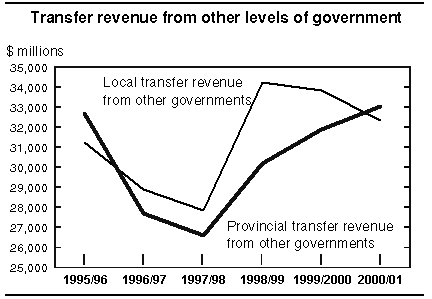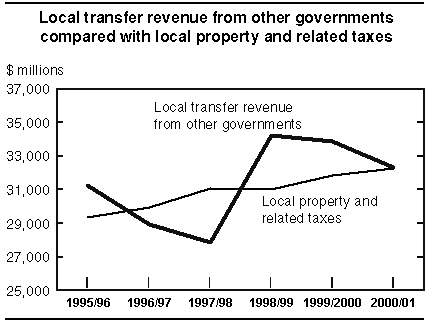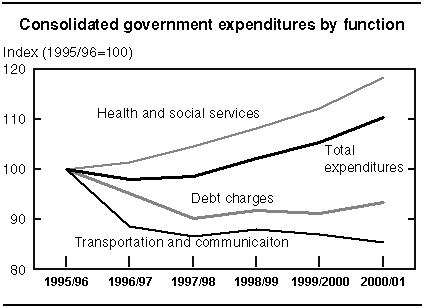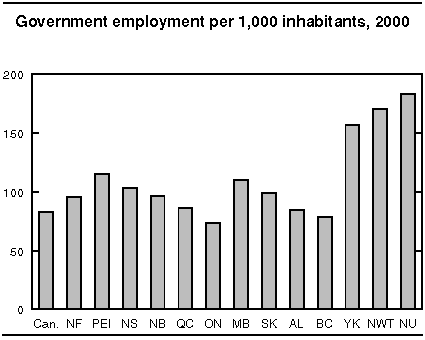
















 |
|
 |                |
Archived ContentInformation identified as archived is provided for reference, research or recordkeeping purposes. It is not subject to the Government of Canada Web Standards and has not been altered or updated since it was archived. Please "contact us" to request a format other than those available. 
The Daily. Wednesday, June 13, 2001 Government finance: Revenue, expenditure and surplus2000/01The fiscal pendulum swung to a strong government surplus of $25.7 billion in 2000/01, in tandem with robust growth in the economy. This has contributed to a $70.9 billion shift in the government finances over the last six years. For a fourth consecutive year, the federal government posted a surplus; it reached $9.1 billion in 2000/01. Provincial and territorial governments recorded a surplus of $11.4 billion, up from $2.2 billion in 1999/2000. However, local governments posted a deficit of $443 million in 2000, down from a surplus of $2.5 billion in 1999. Just over half of the provinces and territories registered surplusesSeven of Canada's 13 provincial and territorial governments registered surpluses in the 2000/01 fiscal year. Alberta's surplus was almost $7.8 billion, the largest of any province or territory. Quebec's was $2.4 billion, and British Columbia's $681 million. The Alberta, Quebec, Ontario and Prince Edward Island governments recorded the largest growth in revenues from 1995/96 to 2000/01. Alberta revenues grew the most, 72.9% over that period. The smallest growth in expenditures over the period was seen in Yukon, Newfoundland, Ontario and New Brunswick. Local governments saw deficits as revenues edged downLocal governments in five provinces and three territories posted deficits for the financial year ending in December 2000. By far the largest deficit was incurred by local governments in Ontario, where spending surpassed revenue by $889 million in 2000. Local government revenues in Ontario increased 9.2% over the five-year period, and spending rose 14.8%.
The largest surplus was posted by local governments in Alberta, an estimated $428 million in 2000. Cumulative revenues during the five-year period rose 21.8% in Alberta. Spending by local governments fell in only three provinces: Newfoundland, Quebec and Nova Scotia. Revenues: Corporate taxes and investment income drive record percentage increasesConsolidated government revenues were $464.6 billion in 2000/01, up 31.8% from 1995/96. Personal income taxes, which represented the lion's share of revenues, rose 30.2% from 1995/96 to $141.5 billion in 2000/01. Companies paid $41.6 billion in federal and provincial/territorial corporate income taxes in 2000/01, up 76.2% from 1995/96. Revenues from contributions to social insurance plans climbed a substantial 33.6% from 1995/96 to 2000/01; the major beneficiaries were the Canada and Quebec Pension Plans (+96.3%), as some premium rates went up and full-time employment increased. From 1995/96 to 2000/01, federal revenues rose 33.2%, provincial and territorial revenues 26.1%, and local government revenues only 7.7%. By comparison, gross domestic product grew 31% over the same period. Total income taxes raised by the federal government rose 46.8% over the five-year period, while those raised by the provinces and territories went up 28.7%. Property taxes grew a moderate 14.3%. Natural resources contributed to a surge in investment income in both Alberta and British Columbia. During the five-year period, oil and gas royalties collected by both governments more than doubled. Alberta collected $10.7 billion in oil and gas royalties in 2000/01, up 119.0% from 1999/2000; British Columbia collected $1.8 billion, up 166.0%. British Columbia also posted a $609 million increase in water royalties. From 1995 to 2000, the growth in revenues outpaced the growth in spending among local governments in six provinces: Quebec, Saskatchewan, British Columbia, Manitoba, Newfoundland and Alberta. 
Property taxes, the main source of local government revenue, rose 14.3% from 1995/96 to $41.0 billion in 2000/01. Revenue in the form of transfers from higher levels of government, the second most important source, peaked in 1998/99 and declined in 1999/2000 and 2000/01. 
Expenditures: Health and social services up, debt charges downExpenditures increased at a much slower pace. Over the five-year period, federal spending rose 3.4%, provincial and territorial spending 13.5%, and local government spending 8.6%. The consolidated government expenditures reached $438.9 billion in 2000/01, up 10.4%. Services provided to the public, as measured by total expenditures less debt charges, reached $380.9 billion in 2000/01, or $12,390 per capita, an 8.4% increase over 1995/96. After accounting for inflation, this represents a 1.6% increase. Expenditures on health and social services rose from $171.2 billion in 1995/96 to $202.7 billion in 2000/01, a rise of 18.4%; total expenditures increased 10.4%. Provincial and territorial government transfers paid to educational, health and social service institutions rose 24.8% from 1995/96 to $70.8 billion in 2000/01. Federal transfers paid to the provinces reached $32.0 billion in 2000/01; this matches their 1995/96 level, but is up 3.4% from 1999/2000, mostly because of transfers for the purchase of medical equipment and equalization payments. Spending on debt charges declined significantly, 6.6% to $57.9 billion in 2000/01, due mostly to lower long-term interest rates. Debt charges fell substantially at the federal and local government levels, but stayed relatively constant for provincial and territorial governments. 
Share of government wages and salaries to total salaries shrankWages and salaries paid by the governments reached $101.1 billion in 2000, up 6.1% from 1999. This amount, which included $2.2 billion of pay equity payments to federal government employees, accounted for 23% of all government expenditures. Government payrolls also represented 19% of all wages and salaries paid to salaried employees in Canada in 2000, compared with 22% in 1995. There were 83 government employees per 1,000 people in 2000, the same number as in 1969. The highest level was recorded in 1991, 97 employees per 1,000. 
Employment ratios for all levels of government tend to be larger in the small provinces and territories. In 2000, Ontario's ratio was 74 per 1,000, compared with 183 in Nunavut. Related CANSIM tables and matrices will be available soon. Data are also available by custom and special tabulations. For more information, or to enquire about the concepts, methods or data quality of this release, contact Joanne Rice (613-951-4354; joanne.rice@statcan.gc.ca), Public Institutions Division. Surplus (deficit) by level of government
Consolidated government revenues and expenditures(1)
Consolidated revenue, expenditure, and surplus (deficit)
| ||||||||||||||||||||||||||||||||||||||||||||||||||||||||||||||||||||||||||||||||||||||||||||||||||||||||||||||||||||||||||||||||||||||||||||||||||||||||||||||||||||||||||||||||||||||||||||||||||||||||||||||||||||||||||||||||||||||||||||||||||||||||||||||||||||||||||||||||||||||||||||||||||||||||||||||||||||||||||||||||||||||||||||||||||||||||||||||||||||||||||||||||||||||||||||||||||||||||||||||||||||||||||||||||||||||||||||||||||||||||||||||||||||||||||||||||||||||||||||||||||||||||||||||||||||||||||||||||||||||||||||||||||||||||||||||||||||||||||||||||||||||||||||||||||||||||||||||||||||||||||||||||||||||||||||||||||||||||||||||||||||||||||||||||||||||||||||||||||||||||||||||||
|
|
|